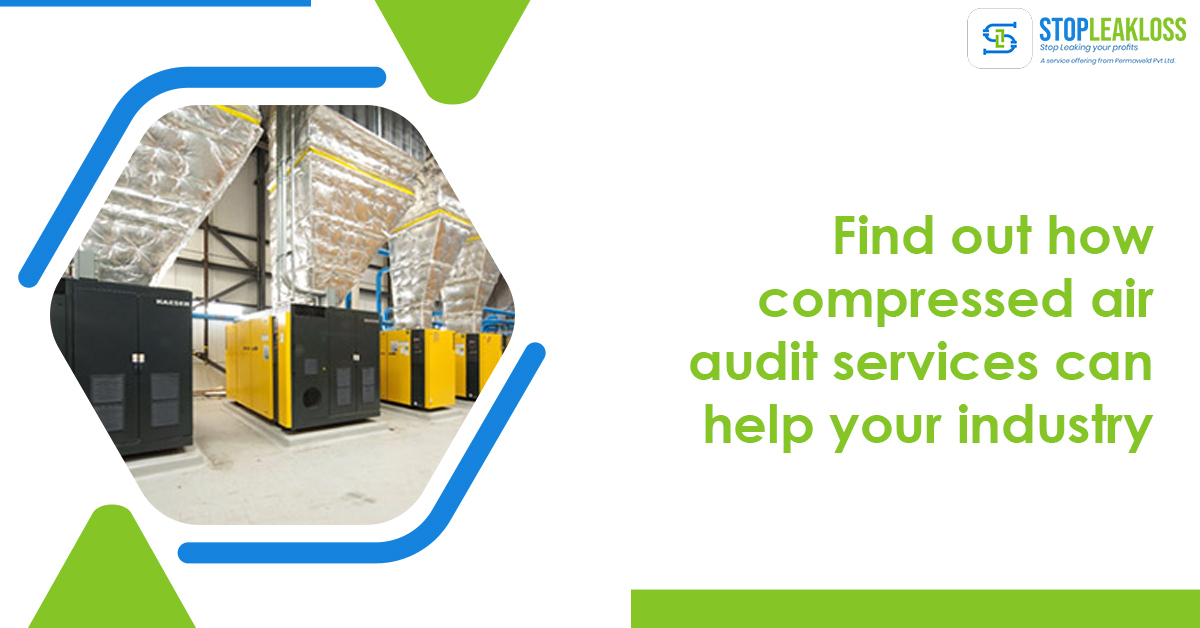
Find out how compressed air audit services can help your industry
A compressed air audit is a precise technique used to identify areas that cause any sort of loss or inefficiency in a compressed air system. Energy audit experts help in finding and repairing defects discovered in compressed air audits.
Understanding compressed air audits:
Energy is a valuable resource, and compressed air is a costly utility used in various activities across several sectors. As a result, sensible, careful, and energy-efficient compressed air utilization is essential since it impacts the feasibility of any processing activity. With over 30 years of research and invention in air compressors, sensors, and services, stopleakloss provides compressed air solutions for any requirement.
Because of our demonstrated history in these domains, we have been able to precisely comprehend issues in the compressed air systems and come up with solution-oriented procedures and equipment for compressed air audits. To guarantee that compressed air systems are used more efficiently, our team of specialist engineers, Electrical, and Instrumentation Engineers perform the audit process and educate end-users with solutions if any errors are present in the major functional areas of the air compressors.
Compressed air auditing is a specialized procedure that needs extensive knowledge and expertise in various sectors to estimate, develop and monitor the effectiveness of energy consumption initiatives.
Compressed air audit Goals and Benefits:
- The compressed air system is accurately measured.
- Reduction in the quantity of energy necessary for utility generation and consumption.
- Any wasted energy is discovered.
- Recycling and energy efficiency
Compressed air accounts for over 40% of a manufacturing facility’s total energy expenses, making a compressed air system efficient is essential. Unfortunately, not all systems are as efficient as they can be, and we see it all the time — compressors that aren’t the right size, old technology, air leaks, pressure dips – the list goes on and on.
The rising cost of electricity is a major concern. According to the Department of Energy, more than half of all industrial air compressors are inefficient, resulting in 3.2 billion dollars worth of energy loss per year. The good news is that factories that focused on cutting down energy expenses could save up to 15% annually with a payback of fewer than two years.
So, how can you ensure a fully efficient compressed air system?
Compressed Air Audits – Analyze Your System’s Health
A compressed air audit on your system is the first step in identifying flaws that may be hindering your product’s performance and unnecessarily increasing energy costs. There are three types of compressed air audits: walk-through assessments, system assessments, and entire system audit.
Evaluation of the Walk-Through
This procedure normally takes 12 to 2 days. It comprises an assessment of the plant’s compressed air system and a study of the distribution system to look for leaks, pressure dips, and compressor sizing concerns. A map of the compressed air system will be created, and a report of faults and solutions on how to fix them will be provided.
System Assessment
For a complete examination, a system assessment is offered, which includes a walk-through and data obtained to identify system dynamics. In addition, the compressed air system mapping will contain details about pressure and other characteristics. Following the completion of the evaluation, the results of the report and suggested solutions will be provided.
Full System Audit
The system audit is the most thorough evaluation and takes 3 to 10 days to complete with minimal to no impact on existing operating processes. Full compressed air system audits include the following:
- Data logging for energy use – records how much energy the air compressors use.
- Air measurement detects the real compressed air demand and operation schedule of a factory.
- Air measurement sees the real compressed air requirement and operation schedule of a factory.
- The quantity of particles in the air system, such as water and oil, is measured as air quality.
- Maintenance review – evaluates the effectiveness of the current maintenance plan.
- Monitoring and control program – gives recommendations to keep the system running at peak efficiency.
Manufacturing Benefits provided by Air Audit services
Manufacturers who utilize compressed air in any industry — to mention a few, food and beverage, automotive, textile, power, electronics, and plastics – will usually realize that a compressed air audit will be highly profitable. Manufacturers will expect gains in energy efficiency, system reliability, and lower operating costs based on the audit results.
For example, during an audit, some firms discover that their compressed air systems operate at a greater pressure than the actual demand resulting in pressure dips, air leaks, or excessive bends in pipe design. If a factory wants 100 psi but must create 120 psi due to air loss, they wasted 20 psi. An audit of your system might help you uncover sources of energy waste like this.
How can Stopleakloss help with compressed air audits?
Our Audit Report contains suggestions for energy-saving measures for the short, medium, and long term and financial projections and analysis for their implementation. These suggestions are accompanied by databases and information sheets derived from measurements and testing carried out in your plant and the outdoors. We also provide support with the implementation and performance monitoring of our energy-saving plans, which is accomplished through the expert services of our engineers and the training of the users’ operators.
With rising energy prices, the performance and efficiency of your compressed air systems are more important than ever. Potential energy savings lower your company’s environmental impact and bottom line. We assist you in reducing power consumption and compressed air system load and consumables and wear and tear, hence increasing the life of the complete compressed air system.




[…] System Dynamics Evaluation – This entails analyzing the data gathered up to this point in order to identify areas for improvement. It entails examining all compressed air users at a facility to determine if compressed air is required for certain uses. (energy audit of compressed air system) […]